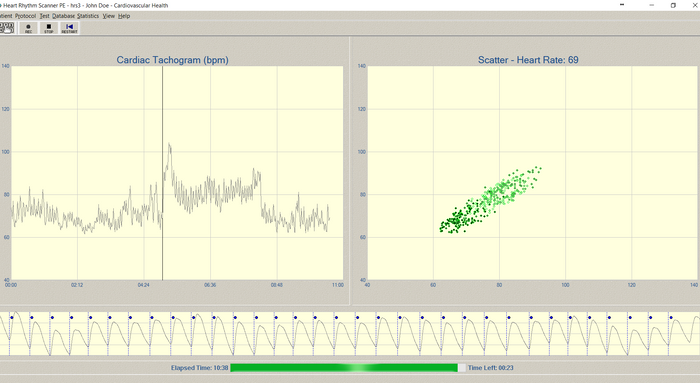Hardware options:
- USB ECG Recorder
- Bluetooth ECG Recorder
Normative database
The results of HRV analysis are compared to the normal ranges based on the large population normative database collected in the specially designed research studies by reputable academic researchers.
Compliance to HRV Standards
The software was developed according to the standards for short-term HRV analysis set forth by:
- The European Society of Cardiology
- The North American Society of Pacing and Electrophysiology
Real-time HRV Monitoring
The HRV Live uses cutting edge HRV technology to measure parasympathetic and sympathetic activities and assess the autonomic balance in the body in real-time. The HRV monitoring of any duration accommodates to any research or health assessment needs. HRV Live performs a full HRV analysis of the last 5 minutes of data every second. It records full array of HRV data to show the dynamics of changes in the regulatory tonus of the autonomic nervous system over time.
Minimum System Requirements
CPU: Intel i3, 2.0 GHz
RAM: 8 Gb
Video: 1024 x 768, 32-bit color
Disk: 2 Gb
USB: One USB 2.0
BLE: Bluetooth 4.0
OS: Windows 10
Key Features
- Assessment of sympathetic and parasympathetic tonus
- Compliance with the standards of short-term HRV analysis
- Real-time continuous monitoring of changes in HRV parameters
- Setting time markers during HRV monitoring and in post review
- Detecting sudden changes in the autonomic balance
- HRV data comparison to the population norms
- Autonomic balance zone diagram for continued comparison
- Variety of views of HRV data: graphs, bars, spectrum, etc.
- Import/Export data to Excel and ASCII format
- Comparison reports associated with time markers
Sensor Options
- USB 1-channel ECG Recorder with three lead wires and pre-gelled disposable ECG electrodes or non-disposable dry ECG electrodes to capture ECG from limbs or chest.
- Bluetooth 1-channel ECG Recorder in the wearable patch form factor with standard pre-gelled disposable ECG electrodes.






































